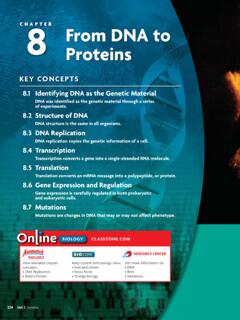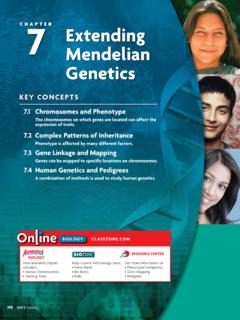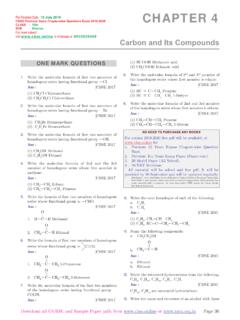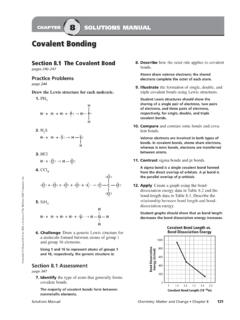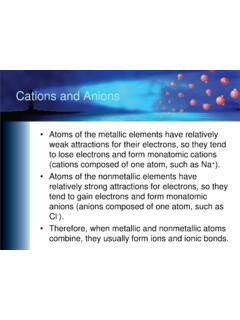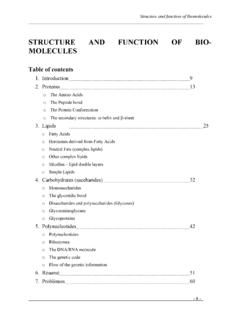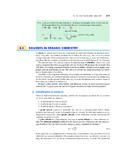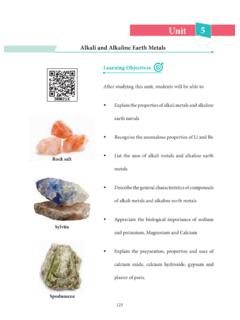Transcription of CHAPTER 2 Chemistry of Life - Weebly
1 CHAPTER . 2 Chemistry of life K E Y CO N C E P T S. Atoms, Ions, and Molecules All living things are based on atoms and their interactions. Properties of Water Water's unique properties allow life to exist on Earth. Carbon-Based Molecules Carbon-based molecules are the foundation of life . Chemical Reactions life depends on chemical reactions. Enzymes Enzymes are catalysts for chemical reactions in living things. BIOLOGY CL ASSZONE .COM. RESOURCE CENTER. BIOLOGY. View animated CHAPTER Keep current with biology news. Get more information on concepts. News feeds Elements of life Hydrogen Bonding Careers Acids, Bases, and pH. Energy and Chemical Polls Reactions Calorimetry Atoms and Bonding 34 Unit 1: Introducing Biology How can this plant digest a frog? Connecting CONCEPTS. L ike other carnivores, the Venus flytrap eats animals to get nutrients that it needs to make molecules such as proteins Cell Function The Venus flytrap has specialized cells on the surfaces of its leaves.
2 Some of these cells allow the plant to snap shut on its prey and nucleic acids. Other chemical com- within seconds. Other cells, such as those that pounds made by the plant's cells enable appear purple in this light the Venus flytrap to digest the animals micrograph, secrete digestive chemicals that allow the that it eats. These chemicals are similar to plant to consume its prey. (LM; magnification 500 ). the chemicals that allow you to digest the food that you eat. CHAPTER 2: Chemistry of life 35. Atoms, Ions, and Molecules KEY CONCEPT All living things are based on atoms and their interactions. MAIN IDEAS VOCABULARY. Living things consist of atoms of atom, p. 36 ionic bond, p. 38. different elements. element, p. 36 covalent bond, p. 39. Ions form when atoms gain or lose molecule, p. 39. compound, p. 37. electrons. Atoms share pairs of electrons in ion, p.
3 38 Review covalent bonds. cell, organism Connect The Venus flytrap produces chemicals that allow it to consume and digest insects and other small animals, including an unlucky frog. Frogs also produce specialized chemicals that allow them to consume and digest their prey. In fact, all organisms depend on many chemicals and chemical reactions. For this reason, the study of living things also involves the study of Chemistry . MAIN IDEA. Living things consist of atoms of different elements. TAKING NOTES What do a frog, a skyscraper, a car, and your body all have in common? Every Use a main idea web to help you physical thing you can think of, living or not, is made of incredibly small make connections among ele- particles called atoms. An atom is the smallest basic unit of matter. Millions of ments, atoms, ions, compounds, and molecules. atoms could fit in a space the size of the period at the end of this sentence.
4 And it would take you more than 1 trillion (1,000,000,000,000, or 1011) years atom: .. to count the number of atoms in a single grain of sand. element Atoms and Elements ion: .. Although there is a huge variety of matter on Earth, all atoms share the same basic structure. Atoms consist of three types of smaller particles: protons, neutrons, and electrons. Protons and neutrons form the dense center of an atom the atomic nucleus. Electrons are much smaller particles outside of the nucleus. Protons have a positive electrical charge, and electrons have a negative electrical charge. Neutrons, as their name implies, are neutral they have no charge. Because an atom has equal numbers of positively charged protons and negatively charged electrons, it is electrically neutral. An element is one particular type of atom, and it cannot be broken down into a simpler substance by ordinary chemical means.
5 An element can also refer to a group of atoms of the same type. A few familiar elements include the gases hydrogen and oxygen and the metals aluminum and gold. Because all atoms are made of the same types of particles, what difference among atoms makes one element different from other elements? Atoms of different elements differ in the number of protons they have. All atoms of a given element have a specific number of protons that never varies. For example, all hydrogen atoms have one proton, and all oxygen atoms have eight protons. 36 Unit 1: Introducing Biology The electrons in the atoms of each element determine the properties of FIGURE The exact position that element. As FIGURE shows, electrons are considered to be in a cloud of electrons cannot be known. They are somewhere in a around the nucleus. The simplified models of a hydrogen atom and an oxygen three-dimensional electron atom on the left side of FIGURE illustrate how electrons move around the cloud around the nucleus.
6 Nucleus in regions called energy levels. Different energy levels can hold different numbers of electrons. For example, the first energy level can hold two electrons, and the second energy level can hold eight electrons. Atoms are most stable when they have a full outermost energy level. Of the 91 elements that naturally occur on Earth, only about 25 are found in organisms. Just 4 elements carbon (C), oxygen (O), nitrogen (N), and hydrogen (H) make up 96 percent of the human body's mass. The other 4 percent consists of calcium (Ca), phosphorus (P), potassium (K), sulfur (S), sodium (Na), and several other trace elements. Trace elements are found in very small amounts in your body, but you need them to survive. For example, iron (Fe) is needed to transport oxygen in your blood. Chromium (Cr) is needed for your cells to break down sugars for usable energy.
7 FIGURE Representing Atoms BOHR'S ATOMIC MODEL SIMPLIFIED MODEL. The model of the atom developed Hydrogen atom (H) Hydrogen atom (H). by Niels Bohr (left) shows that an nucleus: outermost energy atom's electrons are located out- 1 proton (+) level: 1 electron ( ) side the nucleus in regions called H energy levels. Different types of 0 neutrons atoms have different numbers of electrons and energy levels. Often, atoms are shown as Oxygen atom (O) Oxygen atom (O). simplified spheres (right). Different types of atoms are shown in nucleus: outermost energy different sizes and colors. 8 protons (+) level: 6 electrons ( ). 8 neutrons O. inner energy level: 2 electrons ( ). Apply How many electrons would need to be added to fill the outermost energy level of hydrogen? of oxygen? Compounds The atoms of elements found in organisms are often linked, or bonded, to other atoms.
8 A compound is a substance made of atoms of different elements bonded together in a certain ratio. Common compounds in living things include water (H2O) and carbon dioxide (CO2). A compound's properties are often different from the properties of the elements that make up the com- pound. At temperatures on Earth, for example, hydrogen and oxygen are both gases. Together, though, they can form water. Similarly, a diamond is pure carbon, but carbon atoms are also the basis of sugars, proteins, and millions of other compounds. Contrast How are elements different from compounds? CHAPTER 2: Chemistry of life 37. MAIN IDEA. Ions form when atoms gain or lose electrons. Connecting CONCEPTS An ion is an atom that has gained or lost one or more electrons. An ion forms Cell Structure and Function because an atom is more stable when its outermost energy level is full; the gain Several different ions are trans- or loss of electrons results in a full outermost energy level.
9 An atom becomes ported across cell membranes during cell processes. You will an ion when its number of electrons changes and it gains an electrical charge. learn how this transport occurs This charge gives ions certain properties. For example, compounds consisting in Chapters 3 and 4. only of ions ionic compounds easily dissolve in water. Some ions are positively charged, and other ions are negatively charged. The type of ion that forms depends on the number of electrons in an atom's outer energy level. An atom with few electrons in its outer energy level tends to lose those electrons. An atom that loses one or more electrons becomes a positively charged ion because it has more protons than electrons. In contrast, an atom with a nearly full outer energy level tends to gain electrons. An atom that gains one or more electrons becomes a negatively charged ion because it has more electrons than protons.
10 Ions play large roles in organisms. For example, hydrogen ions (H+) are needed for the production of usable chemical energy in cells. Calcium ions (Ca2+) are necessary for every muscle movement in your body. And chloride ions (Cl ) are important for a certain type of chemical signal in the brain. Ions usually form when electrons are transferred from one atom to an- other. For example, FIGURE shows the transfer of an electron from a sodium atom (Na) to a chlorine atom (Cl). When it loses its one outer electron, the sodium atom becomes a positively charged sodium ion (Na+). Its second energy level, which has eight electrons, is now a full outermost energy level. The transferred electron fills chlorine's outermost energy level, forming a negatively charged chloride ion (Cl ). Positive ions, such as Na+, are attracted to negative ions, such as Cl.
